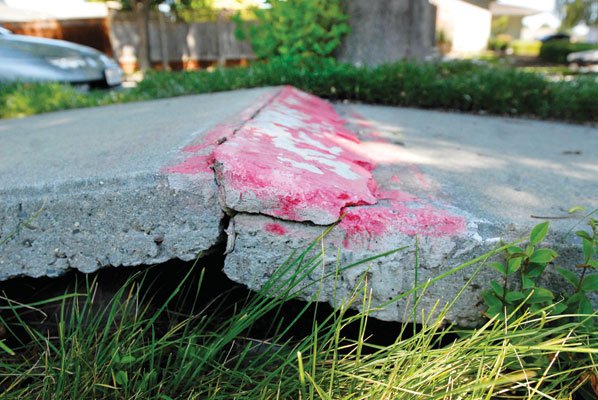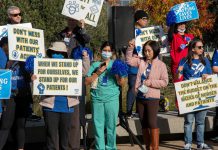After spending more than $13 million on Gilroy Gardens earlier
this year and with a nearly $4 million general fund deficit, Gilroy
just doesn’t have the $7 million to $11 million it will cost to fix
all the broken sidewalks across town, city staff told the council
Monday night.
After spending more than $13 million on Gilroy Gardens earlier this year and with a nearly $4 million general fund deficit, Gilroy just doesn’t have the $7 million to $11 million it will cost to fix all the broken sidewalks across town, city staff told the council Monday night.
In fact, City Hall only has $41,580 left to repair sidewalks until next summer, and at its current spending rate, the repair fund will be broke in about two weeks. That’s because dozens of property owners have taken advantage of the city’s nascent 80-20 program, whereby residents evenly split the cost of sidewalk repair with the city and then pay nothing for new curb and gutters, asphalt and tree removal, so they end up footing about 20 percent of the total cost.
“We’ve never seen anything like this,” City Engineer Rick Smelser said of the program’s “overwhelming success” after reporting the results of the latest sidewalk survey.
Councilman Perry Woodward, who wants the cash-strapped city to somehow pay 100 percent of the sidewalk bill, was skeptical: “67 out of more than 2,500 properties to repair – that’s overwhelming success?”
He then told the council it needs to “dig deeper” and Wednesday added this: “We were told, for the first time by staff, ‘Council, because you voted to buy Gilroy Gardens, there’s no money left to fix sidewalks.’ And that to me is very troubling. We were never told that traveling down the primrose path on the way to buy Gilroy Gardens.”
When it comes to the finances of sidewalk repair, some of those 67 residents hired their own contractors and then billed the city for its 80-percent portion while others had the city do all the work and then sent in a check for about 20 percent. When the city does the legwork, it adds costs to bid the project, clear out the physical area, set up traffic controls and inspect the work, Smelser said. A resident can get things cheaper, though, by avoiding overhead costs and prevailing wage requirements, which was a point of concern among the council. The $11 million projection represents how much repairing all the sidewalks will cost if the city hires contractors, versus the $7 million if residents hire the labor.
The last estimate pegged the total bill at about $7.9 million, and the survey – which left concrete lips orange all over Gilroy – shows that the city likely has millions more in repairs that will take more than 14 years to fix at the current pace. Fast-tracking repairs with, say, a $10 million bond is also out of the question because the city cannot afford to pay it back, according to Finance Director Christina Turner.
The council received all this news with a collective sigh Monday night, nearly a year after Councilmembers Woodward, Bob Dillon, Cat Tucker and Craig Gartman campaigned on promises of covering 100 percent of residents’ sidewalk costs.
“We all campaigned on this damn issue. We all say it’s important,” Councilman Craig Gartman told his colleagues with a firm tone Monday. “Damn it, we need to make a decision.”
Mayor Al Pinheiro lauded the sudden success of the 80-20 program as proof that residents are willing to step up. He and Councilmembers Dion Bracco and Peter Arellano have advocated splitting costs with residents and have pointed to state law mandating that property owners repair their sidewalks, which were the chief recommendations of the 2006 citizen Sidewalk Task Force, along with strong “don’t bond” advise.
New recommendations may surface Sept. 29, when the council will hold a study session. Gartman and Woodward voted against a motion to hold a study session if it meant continuing the 80-20 plan, which will also require an additional full-time employee to administer if the council chooses to continue it, Turner wrote in a memo. Shortly after the first vote, though, the body split 4-3 – with Arellano, Bracco and Pinheiro voting “no” – to hold a study session to essentially “dig deeper,” as Woodward put it.
Pinheiro will be out of town and unable to attend, he said, but he encouraged the body to meet and discuss finances and the city’s first recommended “focus area,” which staff has nominated for free sidewalk repairs. The Texas-shaped area in west Gilroy bound by Wren Avenue, Uvas Park Drive, Ponderosa Drive, Monte Bello Drive and Cypress Court includes Ascencion Solorsano Middle School and deserves a free ride due to extensive sidewalk damage that will cost the city between $847,000 and $1.3 million.
“Why not other, older areas, like Miller Avenue?” Pinheiro asked.
“This is our first cut,” Smelser replied, adding that neighborhoods 20 years or older that are near schools and along designated disabled pathways receive consideration for the free ride.
At the study session, the council will also discuss the city’s street tree policy, which has required residents to plant trees with sidewalk-breaking roots. Council members said they expected to talk about this Monday after directing staff to look at the issue in June, but staff did not prepare anything specifically tree-related, and Community Services Director Susan Andrade-Wax said they would have something within a month.
“We all hoped for more detail. I’m ready to move forward with the 80-20 program,” Bracco said. “But we need a comprehensive street tree policy … Each time this comes up.”
Sidewalks: By the numbers
– 11,120: Property sites surveyed
– 2,555: Sites in need of repair
– 101: Cans of orange spray paint used to mark broken sidewalks
– $11.7 million: Total cost to repair sidewalk areas* if city does all the work
– $7.4 million: Total cost if residents hire contractors and then bill city
– $6.7 million: Cost to just repair/replace sidewalk and tree if city does all the work
– $4.2 million: Cost to just repair/replace sidewalk and tree if residents hire labor
– $7.9 million: Total cost to repair sidewalk areas, according to 2006 survey
– $6.2 million: Total cost to repair sidewalk areas, according to 2002 survey
– $325,128: Amount budgeted for sidewalk repair this fiscal year
– $41,580: Amount left
– $455,219: Amount spent on sidewalk repair last fiscal year
– 67: Number of property owners who have taken part in the 80-20 program since its June inception
– 72: Number of property owners on waiting list
– 22: Average number of applicants per month
– $5,000: Average sidewalk area repair cost per property
– $4,200: Average of city’s share under 80-20 program
– 4: Average number of 50-50 applicants per month since 1993
– $3.4 million: Total value of sidewalk repairs since 50-50 program began in 1993
* “Sidewalk area” includes removing and replacing sidewalk, grinding, tree replacement with root barriers, ADA ramps for corner properties, curb and gutter replacement and driveway and parkstrip improvements.















